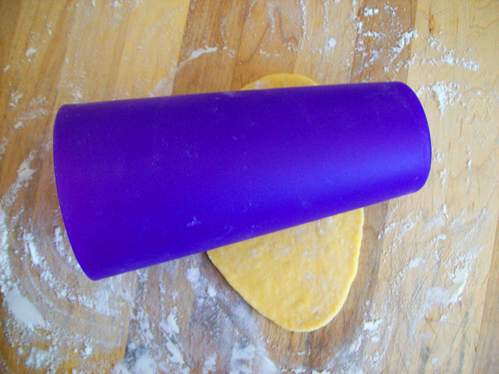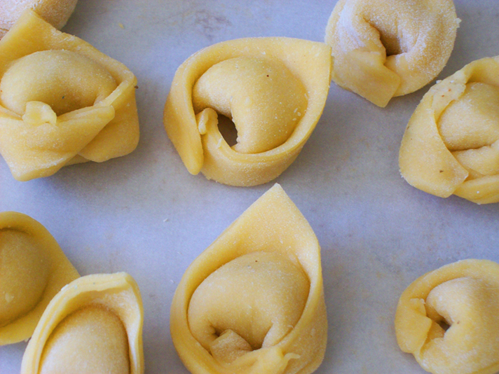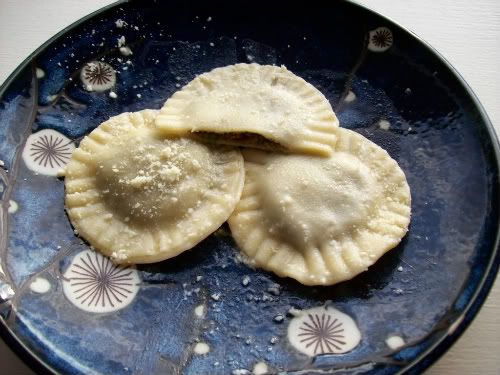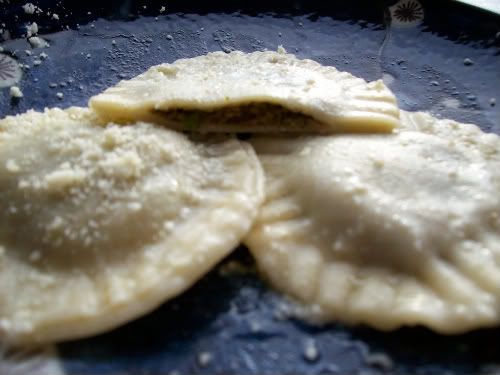Let me tell you a few stories about the times I’ve made pasta from scratch.
The first time was at the beginning of last July. That summer, I had made a deal with my mother: it was okay if I didn’t get a job if I cooked at least five days a week, and kept the house in a reasonable amount of order. That summer was my time for learning: I taught myself to follow new recipes, learned new cooking techniques, and generally found out how to operate in our kitchen. New, challenging things excited me.
One day, I decided to make Italian Sausage Soup with Tortellini. I told my mother the dinner plans, but not the rest of the secret: we were out of tortellini. She didn’t guess, and after having a friend over for a few hours, I gleefully got to work.
The thing about our kitchen at the time was that even though it was well-stocked with a treasure trove of gadgets, it lacked one crucial item: a rolling pin. We’d had a wooden one years ago, but it had either disappeared or been irreparably broken – either that, or sacrificed to the gods of clay and play dough.
When making pasta, it’s absolutely necessary to have a rolling-pin-type instrument if you don’t have a pasta machine (and sometimes, even if you do). But I like to think of myself as a resourceful creature, so I used what we had: a tall, purple, plastic drinking cup.

Perhaps the tortellini turned out a bit too thick, but they suited the soup well, with a chicken, Parmesan, and mushroom filling, and they were awfully cute.

The second time I made pasta from scratch was sometime last autumn. I’d been in my college apartment for a few months, and had been trying to make something special every time it was my turn to cook. Let me tell you, Sweet Potato Ravioli with Pecans and Brown Butter Herb Sauce is no exception.
Thankfully, we had a rolling pin, although not much of a surface to do the rolling on, considering our apartment kitchen has tile countertops. (My mother’s kitchen is the same, but there’s also a big wooden cutting board that rolls out like a drawer, and is removable, should you so desire it to be so.) There was instead a large, plastic cutting board that we had theretofore used for drying dishes when our dish drainer overflowed.
Let me tell you, even with a real rolling pin, this ravioli-making was nearly an all-day endeavor – or maybe, an all-night one. I had to make it in two batches, because otherwise, I wouldn’t have been able to eat. (Thank goodness one or two of my roommates were coming home late.) I can also tell you that it was absolutely delicious. We treated ourselves to fresh sage, and I fell in love. If you’ve ever wondered about the silly name of this blog, well, there’s a hint. We ate some of the leftover filling with a spoon. I didn’t take any pictures because it had long-since gotten dark, and I was too tired to move.
The third time I made pasta, it was for Thanksgiving. My stepmother had heard about my recent interest in cooking, and was looking to have me help out with the feast. She was looking to put a new spin on the old traditions, and I thought my sweet potato ravioli was a perfect fit for the theme.
Just a little bit before that, my mother, having heard about my latest pasta-making endeavors, promised me a pasta machine. She said she had one, but when we dug it out of the laundry room cupboards, we discovered it was for clay only. (Who ever heard of such a thing? Haven’t you always wanted to eat clay-studded linguini?) Not to be discouraged, we headed out to Bed, Bath & Beyond, and found a nice pasta machine on sale.
Nice, but a little bulky and heavy when it’s crammed into your suitcase, and you’ve got to take said suitcase on Amtrak for a three-hour ride (with holdups) on what the conductor has announced is the busiest day of the year, so please put your luggage on your lap to make room for the other passengers, thank you very much. (Thankfully, most people cleared out early on – my stop was the second-to-last – and I could put my suitcase on the floor.)
But that was just the beginning, of course. First, I didn’t let the dough rest in the refrigerator, so it looked nasty and discolored, and didn’t behave right. Fortunately, I did end up putting it in, and it turned out fine.
Then, the pasta machine is supposed to clamp down on the counter, so you can turn the dough through it more easily. The trouble was that my stepmother has really nice counters, so we could not attach the clamp to them. One of us then had the brilliant idea to have my father physically hold down the pasta machine while my stepmother or I fed the dough through. So there we were, three of us huddled round the dumb thing, trying to figure it out. We’d try to feed the dough through, and my father could barely keep the machine against the counter, because the dough was so thick and tough (as it’s supposed to be, thus the inclusion of a clamp). When we did get enough dough through, it would bunch on the sides and tear in the middle, so that we had to keep feeding it through on the same setting, to much of the same result each time.
In the end, we just gave up on the pasta machine, and my father found a rolling pin.
We meticulously stuffed our raviolis, lovingly pressing fork tines around the square edges, and marveling at the little guys as they bounced around in boiling water on the stove.
But when we excitedly picked them up with our forks and took a bite, we learned that we hadn’t gotten the dough thin enough, and it seemed like our raviolis were more dough than filling. There were bits of dough left on all plates.
It’s said that the third time’s the charm, but I don’t believe it. I think it’s the fourth time. Because the fourth time I made pasta from scratch, it couldn’t have been more perfect.
It was the beginning of finals week. We were supposed to go to the grocery store, but hadn’t been able to get organized enough to do it. We had also decided that there would be no scheduled cooking for that week, because everyone would be stressed and under too much pressure.
Personally, I’m a procrastinator, so I never have much to do during finals week until the end. I also get stressed out easily, but I find cooking and baking relieves that stress. Also, a fair amount of food during finals week is pretty necessary to have around.
Only, we didn’t. I was horrified at the thought of no dinners for four days. So I decided to get resourceful for most of them. I scoured the cupboards. I scoured them so hard that my brother’s graduation present was a dozen shortbread cookies – they require no eggs, no milk; just flour, cornstarch, butter, and sugar.
One night, I stumbled across a recipe for pistachio pesto. I looked in the cupboards. We had a half a Safeway bag of pistachios, and a half a Costco bag of Craisins. And I had an idea. I made sure everyone (or almost everyone) would be home for dinner that night. Then I fished out the pasta machine and the food processor using my chair-slash-stool, made the dough, and set to work on the filling.
When it came time to use the pasta machine, I got nervous. Unlike my stepmother’s counters, ours are not something we can or should display proudly when we have company. Therefore, I thought, it would be no problem to use the clamp on them. Guess again. The clamp was too small, the counter too thick. I glanced around frantically, and eventually, my eyes settled on the dining room table. It would have to do.
I cleared it of my roommates’ study materials, wiped it down, dried it off, and sprinkled a corner of it with flour (I put an empty garbage bag beneath the table, to catch said flour later). Then, I carefully attached the clamp. I was afraid, because the table, while good, isn’t necessarily the sturdiest thing – or at least, I didn’t expect it to be with a pasta machine attached to it. I remembered my father pressing down with all his might to keep that machine down, and imagining all that pressure applied to our poor table. Frankly, I was expecting the table to break. Or at least protest enough that I would have to get out that stupid rolling pin. If I already wouldn’t have to, because of the stupid pasta machine.
But then, a miracle happened. You know how, sometimes, you struggle with something, give up, and then come back a few days, weeks, months, years, etc., later, after your brain has had time to work through the problem, and it’s like there was never a problem to begin with? That was my miracle. I guess the pieces of pasta we’d been trying to feed through the machine were too big, because I divided the dough into smaller pieces, flattened a little with my hands, and then fed them through, one at a time, on the thickest setting. After maybe one time of struggling, they all went through, as near-perfect as possible.
With the tingly feeling of Luck’s presence at my side, I decided to be daring. I’d switch it to the thinnest setting, just to see if it would work.
It did. My beautiful, glorious pasta machine spat out paper-thin sheets of pasta into my waiting hands.
This fourth time was no less work than the other three. I was sweating profusely, and my arms ached from all the times I had to turn that crank. And I swear, it took me an hour to fill all those little circles – I used a medium-sized biscuit-cutter this time, inspired by the wonton wrappers most recipes tell you to use. There were a lot of them, after all, since I’d pressed the dough so thin. I did them batches like I’d done before, so that I could eat. The reason the raviolis in the photos are so thin and ugly is because they’re from the second batch, when I’d started to run out of filling (but not dough). I should’ve grabbed some from the first batch, but they were eaten up almost as soon as I could put them on the table.
I was worried that they’d be too thin, since I’d used the lowest setting on the dough. Turns out, it was just right. Even the raviolis that weren’t filled as full as they could be, because they were out of the second batch, weren’t doughy at all.
Pasta-making is not easy. It gets easier the more times you do it, but it will always be labor-intensive and exhausting. I had gotten about four hours of sleep the night before, because I couldn’t fall asleep till late, and had to wake up at six in order to get to my eight AM, Saturday final. From start to finish, the ravioli-making took me about three hours, not including the hour or so the dough had to rest. What I do remember is that afterward, I hobbled upstairs, and took a nap until eleven that night. I woke up long enough to brush my teeth, wash my face, and change into pajamas, and then I went back to sleep. Including the nap, I slept for fourteen hours. I can guarantee you that even if I had gotten a full night’s sleep the night before, I’d still have slept at least twelve.
If you’re going to make pasta for your main dish like this, or for any dish, you need to be prepared for it. Well. You can never really be prepared, especially if it’s your first time making it. But you have to know that it’s going to take a while, and that it’s going to take work. You also have to know that you will never feel prouder than when you see that little ravioli, or little tortellini, or little whatever, staring up at you from the counter, because you know you’ve put everything you have into it – your love, your curses, your labor. Even if they don’t turn out as beautiful as you hoped, or as tasty as you dreamed, your efforts have still physically manifested themselves in your kitchen. You’ve made something that most people will buy in a store. You’ve experienced something that most people won’t. It’s like a little secret you keep tucked inside your chest, a ray of sunshine that warms your heart and makes you smile. You’ve made this thing. Now eat it, share it, love it.

PISTACHIO-CRANBERRY PESTO RAVIOLI
filling recipe adapted from Vegetarian Perspective,
dough recipe from Weston Brand Pasta Machine instruction booklet
Dough Ingredients
3 eggs
2-1/2 cups all purpose flour
olive oil, if needed
Filling Ingredients
1 cup raw shelled pistachios
1/2 cup dried cranberries
2 cloves garlic
1/2 cup olive oil
1/2 teaspoon salt
1 teaspoon coriander
1 teaspoon lime juice (optional)
1 egg
Parmesan cheese, to taste (at least 1/4 cup)
Directions
For dough:
Pour flour into a mixing bowl and make a "well" or pit into the center. Break the eggs into the well. Using a fork, slowly blend the flour and eggs until they are well blended. If the mixture is too wet, add a little flour; if the mixture is too dry, slowly add a little water or olive oil, or even an extra egg, if you find it necessary.
Spread a light coating of flour on a table or countertop. Place the dough mixture on the floured surface and begin to firmly knead the dough. Continue kneading until the dough has a consistent color and texture.
Form the dough into a mound shape and wrap in plastic wrap, or seal inside a plastic Ziplock bag. Refrigerate for at least an hour. When ready to use, take it out of refrigerator and let sit on counter for about twenty minutes; if needed, warm with hands.
For filling:
Put cranberries in a bowl with a little water. Microwave for two minutes to soften. Place all ingredients in a food processor and blend until a fine paste forms. This filling is all about taste, so the amounts of each ingredient are utterly up to you. Play with the mixture until you find something you like.
To assemble:
Roll out dough or crank through pasta machine until it is as thin as you can possibly get it. This is ideally paper-thin, or at least 1/8"-thick. Cut pasta into an even number of desired shapes (square or round; I found that a 3.5" circular biscuit cutter was perfect). For each ravioli, you will need two pieces of dough. Add a dollop of filling to one of the pieces. Use finger to brush an outline of water around the edges. Then place non-filled shape of dough on top, squeezing the edges or pressing down with fork tines (or both) to seal. You can cover the finished raviolis with a damp paper towel while you work on the rest, but do not stack or allow edges to touch, as they will stick together.
Boil ravioli in batches for about five minutes, or until raviolis float to the top of the water.

No comments:
Post a Comment